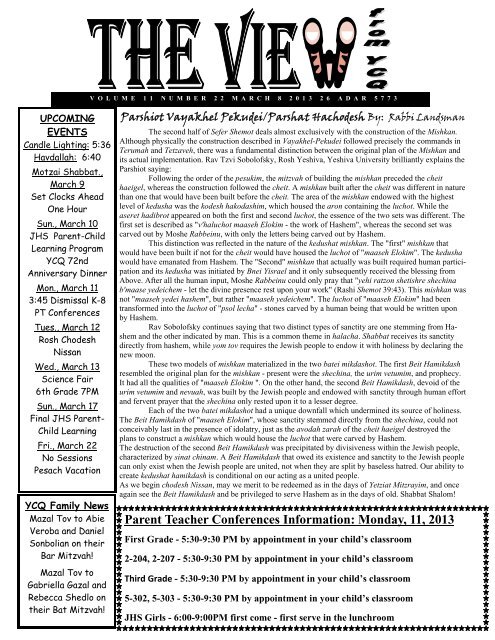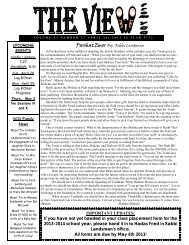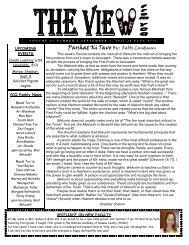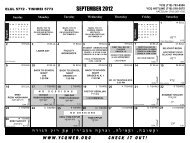Create successful ePaper yourself
Turn your PDF publications into a flip-book with our unique Google optimized e-Paper software.
UPCOMING<br />
EVENTS<br />
Candle Lighting: 5:36<br />
Havdallah: 6:40<br />
Motzai Shabbat.,<br />
March 9<br />
Set Clocks Ahead<br />
One Hour<br />
Sun., March 10<br />
JHS Parent-Child<br />
Learning Program<br />
YCQ 72nd<br />
Anniversary Dinner<br />
Mon., March 11<br />
3:45 Dismissal K-8<br />
PT Conferences<br />
Tues., March 12<br />
Rosh Chodesh<br />
Nissan<br />
Wed., March 13<br />
Science Fair<br />
6th Grade 7PM<br />
Sun., March 17<br />
Final JHS Parent-<br />
Child Learning<br />
Fri., March 22<br />
No Sessions<br />
Pesach Vacation<br />
YCQ Family News<br />
Mazal Tov to Abie<br />
Veroba and Daniel<br />
Sonbolian on their<br />
Bar Mitzvah!<br />
Mazal Tov to<br />
Gabriella Gazal and<br />
Rebecca Shedlo on<br />
their Bat Mitzvah!<br />
V O L U M E 1 1 N U M B E R 2 2 M A R C H 8 2 0 1 3 2 6 A D A R 5 7 7 3<br />
Parshiot Vayakhel Pekudei/Parshat Hachodesh By: Rabbi Landsman<br />
The second half <strong>of</strong> Sefer Shemot deals almost exclusively with the construction <strong>of</strong> the Mishkan.<br />
Although physically the construction described in Vayakhel-Pekudei followed precisely the commands in<br />
Terumah and Tetzaveh, there was a fundamental distinction between the original plan <strong>of</strong> the Mishkan and<br />
its actual implementation. Rav Tzvi Sobol<strong>of</strong>sky, Rosh <strong>Yeshiva</strong>, <strong>Yeshiva</strong> University brilliantly explains the<br />
Parshiot saying:<br />
Following the order <strong>of</strong> the pesukim, the mitzvah <strong>of</strong> building the mishkan preceded the cheit<br />
haeigel, whereas the construction followed the cheit. A mishkan built after the cheit was different in nature<br />
than one that would have been built before the cheit. The area <strong>of</strong> the mishkan endowed with the highest<br />
level <strong>of</strong> kedusha was the kodesh hakodashim, which housed the aron containing the luchot. While the<br />
aseret hadibrot appeared on both the first and second luchot, the essence <strong>of</strong> the two sets was different. The<br />
first set is described as "v'haluchot maaseh Elokim - the work <strong>of</strong> Hashem", whereas the second set was<br />
carved out by Moshe Rabbeinu, with only the letters being carved out by Hashem.<br />
This distinction was reflected in the nature <strong>of</strong> the kedushat mishkan. The "first" mishkan that<br />
would have been built if not for the cheit would have housed the luchot <strong>of</strong> "maaseh Elokim". The kedusha<br />
would have emanated from Hashem. The "Second" mishkan that actually was built required human participation<br />
and its kedusha was initiated by Bnei Yisrael and it only subsequently received the blessing from<br />
Above. After all the human input, Moshe Rabbeinu could only pray that "yehi ratzon shetishre shechina<br />
b'maase yedeichem - let the divine presence rest upon your work" (Rashi Shemot 39:43). This mishkan was<br />
not "maaseh yedei hashem", but rather "maaseh yedeichem". The luchot <strong>of</strong> "maaseh Elokim" had been<br />
transformed into the luchot <strong>of</strong> "psol lecha" - stones carved by a human being that would be written upon<br />
by Hashem.<br />
Rav Sobol<strong>of</strong>sky continues saying that two distinct types <strong>of</strong> sanctity are one stemming from Hashem<br />
and the other indicated by man. This is a common theme in halacha. Shabbat receives its sanctity<br />
directly from hashem, while yom tov requires the Jewish people to endow it with holiness by declaring the<br />
new moon.<br />
These two models <strong>of</strong> mishkan materialized in the two batei mikdashot. The first Beit Hamikdash<br />
resembled the original plan for the mishkan - present were the shechina, the urim vetumim, and prophecy.<br />
It had all the qualities <strong>of</strong> "maaseh Elokim ". On the other hand, the second Beit Hamikdash, devoid <strong>of</strong> the<br />
urim vetumim and nevuah, was built by the Jewish people and endowed with sanctity through human effort<br />
and fervent prayer that the shechina only rested upon it to a lesser degree.<br />
Each <strong>of</strong> the two batei mikdashot had a unique downfall which undermined its source <strong>of</strong> holiness.<br />
The Beit Hamikdash <strong>of</strong> "maaseh Elokim", whose sanctity stemmed directly from the shechina, could not<br />
conceivably last in the presence <strong>of</strong> idolatry, just as the avodah zarah <strong>of</strong> the cheit haeigel destroyed the<br />
plans to construct a mishkan which would house the luchot that were carved by Hashem.<br />
The destruction <strong>of</strong> the second Beit Hamikdash was precipitated by divisiveness within the Jewish people,<br />
characterized by sinat chinam. A Beit Hamikdash that owed its existence and sanctity to the Jewish people<br />
can only exist when the Jewish people are united, not when they are split by baseless hatred. Our ability to<br />
create kedushat hamikdash is conditional on our acting as a united people.<br />
As we begin chodesh Nissan, may we merit to be redeemed as in the days <strong>of</strong> Yetziat Mitzrayim, and once<br />
again see the Beit Hamikdash and be privileged to serve Hashem as in the days <strong>of</strong> old. Shabbat Shalom!<br />
Parent Teacher Conferences Information: Monday, 11, 2013<br />
First Grade - 5:30-9:30 PM by appointment in your child’s classroom<br />
2-204, 2-207 - 5:30-9:30 PM by appointment in your child’s classroom<br />
Third Grade - 5:30-9:30 PM by appointment in your child’s classroom<br />
5-302, 5-303 - 5:30-9:30 PM by appointment in your child’s classroom<br />
JHS Girls - 6:00-9:00PM first come - first serve in the lunchroom
YCQ Annual Book Fair<br />
This past Tuesday and Wednesday we had our annual Book Fair. Students<br />
were able to attend this special fair organized by the PA to pick out and<br />
purchase age level appropriate books with the help <strong>of</strong> their teachers. The<br />
fair was still open on Wednesday night for those parents attending parent<br />
teacher conferences. Thank you so much to Mrs. Marjorie Wein and her<br />
team <strong>of</strong> parent volunteers for the amazing Book Fair!<br />
Names Not Numbers Trip to The Museum Heritage<br />
“Names Not Numbers” continued this week, beginning Monday with a trip to the Museum <strong>of</strong><br />
Jewish Heritage. Participants were welcomed to the museum and given a private tour <strong>of</strong> the<br />
Holocaust exhibits, with special attention given to survivor testimonials. After a delicious<br />
lunch was served, students heard from Dr. Paul Radensky, educational director. He spoke on<br />
the topic <strong>of</strong> ethical wills. On Tuesday, two more survivors were interviewed by our students<br />
as the movie making continued. On Friday, students began the editing process, learning how<br />
to take their raw film footage and begin shaping it into a movie.
Amazing Ruach at the JHS Girls Shabbaton<br />
This past Shabbat the JHS girls enjoyed a wonderful shabbaton at the Raleigh Hotel.<br />
Upon their arrival the girls participated in activities including a talent show with Morah<br />
Ivgi and swimming. Pre-Shabbat ruach was a blast. After Kabbalat Shabbat, during the<br />
first Shabbat meal, everyone heard beautiful Divrei Torah. The guest speaker, Mrs. Devorah<br />
Kigel, Noted Lecturer at NYU, Rutgers, Touro College, EMET, Discovery, AishConnections,<br />
and Manhattan Jewish Experience, shared Divrei Torah and astounded the audience<br />
with her amazing stories <strong>of</strong> her becoming a Baalat Teshuva. The girls enjoyed an<br />
oneg Shabbat and watched their morot perform skits. The girls enjoyed a learning program<br />
and games with their counselors on Shabbat morning. On Motzai Shabbat the girls<br />
had fun singing and dancing during their ruach filled melave malka. Thank you to all<br />
the morot, chaperones and students for making this the best Shabbaton ever!<br />
Kindergarten Visits the Matzah Bakery<br />
This past Monday, the Kindergarten visited the Chabbad Children’s Matzah Bakery.<br />
There, they experienced the process <strong>of</strong> baking matzah from separating the wheat, to<br />
mixing the flour, rolling the dough and even making the holes. While the matzah was baking,<br />
the children made a Pesach craft. They created a beautiful drinking cup that will be<br />
sent home for them to use on Pesach. When they returned to school, the children got to<br />
eat the delicious matzot that they baked!
YCQ SPECIAL SUNDAY LEARNING PROGRAM<br />
PLEASE JOIN US THIS SUNDAY<br />
MARCH 10, 2013<br />
9 AM - 11 AM<br />
28 ADAR 5773<br />
FOR AN INSPIRATIONAL<br />
LEARNING PROGRAM FROM<br />
SPEAKER:<br />
Rabbi Pearl, JHS Rebbe<br />
TOPIC:<br />
Tziztit to Dye for/<br />
The Mitza <strong>of</strong> Techelet
ATTENTION ALL DINNER PARTICIPANTS:<br />
We look forward to greeting you personally at the <strong>Yeshiva</strong>’s 72nd Anniversary<br />
Dinner which will take place THIS SUNDAY, March 10, at the Sands <strong>of</strong><br />
Atlantic Beach. The reception will begin promptly at 4:30 P.M. followed by<br />
dinner at 6:00 P.M.<br />
We hope you enjoy the evening.<br />
Reize Sipzner<br />
Dinner Chairperson<br />
P.S. If you are unable to attend, please call the <strong>Yeshiva</strong> before Friday, March 8. After<br />
Friday, contact Mrs. Reize Sipzner: (917) 365-4321 or<br />
Rabbi Kovitz: (917) 860-4758<br />
DIRECTIONS<br />
To The Sands, Atlantic Beach<br />
From Brooklyn<br />
Belt Parkway east to Exit 19, Route 878 Nassau Expressway. Continue on<br />
Route 878, which becomes Rockaway Boulevard. Continue on Rockaway<br />
Blvd. about 1 ½ miles going toward Long Beach and the Atlantic Beach<br />
Bridge. Bear right and Rockaway Blvd. will again become 878 Nassau Expressway<br />
(watch for overhead sign “RT 878”). After crossing toll bridge, bear<br />
left around the traffic circle and continue to The Sands, approximately one<br />
mile on the right.<br />
From New York City and <strong>Queens</strong><br />
Long Island Expressway to Exit 22, Grand <strong>Central</strong> Parkway. Grand <strong>Central</strong><br />
Parkway to Exit 13S, Van Wyck Expressway/JFK Airport. Take the Van Wyck<br />
Expressway to Exit 1, Route 878 East, Nassau Expressway (Note that Exit 1 is<br />
a left lane exit from the Van Wyck Expressway. After exiting, move immediately<br />
to the far right lane.) Continue on 878 as above.<br />
From Eastern Long Island<br />
Meadowbrook Parking south to Exit M10 – Loop Parkway. At the end <strong>of</strong> Loop<br />
Parkway, bear right onto Lido Boulevard, which becomes Park Avenue in Long<br />
Beach, and then becomes Park Street in Atlantic Beach. Turn left at the end <strong>of</strong><br />
Park Street onto Oswego Avenue. Proceed one block to Beach Street. Then<br />
turn right and proceed to The Sands on the left.
Parsha Primer<br />
שדוח<br />
#490 March 9, 2013 VAYAKHEL-PEKUDEI<br />
ג"עש ת רדאב<br />
ז"כ ד"סב<br />
PARSHA IN A NUTSHELL- השרפה םוכיס<br />
In our parshiot Bnei Yisrael carry out Hashem’s command<br />
to build the Mishkan.<br />
Vayakhel - Bnei Yisrael donated the various materials<br />
that were needed to produce the Mishkan. At some<br />
point the workers turned to Moshe and told him that<br />
they already had more materials than necessary.<br />
Moshe commanded Bnei Yisrael to stop bringing the<br />
materials. The leaders <strong>of</strong> the tribes donated the<br />
precious stones that were needed for the clothing <strong>of</strong><br />
the Cohen Gadol.<br />
The parsha details the building <strong>of</strong> the Mishkan<br />
and its vessels. Bnei Yisrael prepared the structure <strong>of</strong><br />
the Mishkan, (the beams that formed the walls, the<br />
coverings and the curtains that separated each<br />
section) and the vessels: the aron, the shulchan<br />
(showbread table), the menorah, the golden altar, the<br />
copper altar and the washstand (kiyor).<br />
Pekudei - The funds used to build the Mishkan were<br />
carefully counted and accounted for, and the garments<br />
<strong>of</strong> the Cohanim were produced.<br />
Moshe blessed the workers who built the<br />
Mishkan when he reviewed the various items, and saw<br />
that they were all built as Hashem specified.<br />
Hashem commanded Moshe to put the<br />
Mishkan together (on Rosh Chodesh Nissan,<br />
almost a year after leaving Mitzrayim), and to<br />
anoint and sanctify the vessels and the Cohanim.<br />
Moshe did everything as Hashem commanded,<br />
and placed the vessels in the Mishkan.<br />
The Divine Presence settled upon the Mishkan,<br />
bringing the building <strong>of</strong> the Mishkan to a successful<br />
conclusion.<br />
<br />
VAYAKHEL-PEKUDEI-HACHODESH 5773<br />
Candle lighting: Havdala:<br />
In loving memory <strong>of</strong> my grandmother<br />
Esther bat Yehuda Leib ל " ז ב"סשת ןסינ 'ב<br />
Parsha Primer (2013) 5773 Tzvi Harris, Halacha Yomit. Graphics from various<br />
clip art collections. Biblical translations based on “The Living Torah” by Rabbi<br />
Aryeh Kaplan z”l. For information on this and other educational programs please<br />
contact: Tzvi Harris 972-54-6584409 (Israel). tzvi@halachayomit.com<br />
Please visit our website: www.halachayomit.com<br />
ירפמ<br />
השרפה<br />
This week we read the final two parshiot <strong>of</strong> Sefer Shmot, Vayakhel and Pekudei. We'll also read the final <strong>of</strong> the four<br />
special parshiot, Parshat Hachodesh, from a second sefer Torah, and pray that the new month <strong>of</strong> Nissan (Rosh<br />
Chodesh on Tuesday) will be a good month. In honor <strong>of</strong> the completion <strong>of</strong> the Mishkan described in our parsha,<br />
Mitzvah <strong>of</strong> the Week will review a brief history <strong>of</strong> the wanderings <strong>of</strong> the Mishkan. Middah <strong>of</strong> the Week will discuss<br />
the mitzvah <strong>of</strong> tzedaka, a mitzvah that can seem difficult at times. Shabbat Shalom!<br />
Shmot 35:1-40:38<br />
תבש ליל<br />
ה-ידוקפ-להקיו<br />
The History <strong>of</strong> the Mishkan<br />
P ars ha Pr im er VAYA K HE L-PE K UD E I - HA C H OD E S H 57 73 1<br />
הינש הדועס<br />
MITZVAH OF THE WEEK עובשה תווצמ<br />
In the year following yetziat Mitzrayim (the exodus from<br />
Egypt) Bnei Yisrael were instructed to build the Mishkan.<br />
Bnei Yisrael served Hashem in the Mishkan for 479 years.<br />
This week we’ll review the history <strong>of</strong> the Mishkan.<br />
The Desert and Gilgal<br />
Bnei Yisrael moved 42 times during their stay in the<br />
desert. The Mishkan wasn’t built yet during the early travels<br />
<strong>of</strong> Bnei Yisrael in the desert, but from its creation it moved<br />
with them 31 times during the 39 years <strong>of</strong> its existence in the<br />
desert. Upon being led into Eretz C’naan by Yehoshua, the<br />
Mishkan was set up in Gilgal for the duration <strong>of</strong> the 14 years<br />
that it took to conquer and divide the land.<br />
Shilo<br />
The longest stretch <strong>of</strong> Mishkan history began when the<br />
Mishkan moved from Gilgal to Shilo. Yehoshua set up the<br />
Mishkan in Shilo, and it remained there throughout the period<br />
<strong>of</strong> the sh<strong>of</strong>tim (judges). The prophet Shmuel (Samuel) was<br />
born after his mother prayed in the Mishkan for a child, and<br />
was blessed by Eli the Cohen Gadol.<br />
The Mishkan took on a special form in Shilo, when its<br />
wooden walls were replaced with walls <strong>of</strong> stone. Everything<br />
else remained the same. The remains <strong>of</strong> the Mishkan at<br />
Shilo are part <strong>of</strong> a fascinating archaeological excavation that<br />
is located near modern-day Shilo. The residents <strong>of</strong> today’s<br />
Shilo built their Beit Knesset in a manner that resembles the<br />
Mishkan, and even named it “Mishkan Shilo.” The Mishkan<br />
remained at Shilo for 369 years!<br />
Nov and Giv’on<br />
The final two locations <strong>of</strong> the Mishkan were at Nov and<br />
Giv’on. Both <strong>of</strong> these places play prominent roles in the Bible.<br />
Together, the Mishkan resided for 57 years in these places.<br />
Shlomo Hamelech (King Solomon)<br />
Finally, 480 years after leaving Mitzrayim, King<br />
Solomon dedicated the Beit Hamikdash in Yerushalayim.<br />
The materials <strong>of</strong> the Mishkan that could be used in building<br />
the Beit Hamikdash were used, and the remaining materials<br />
were stored in secret tunnels under the Beit Hamikdash. This<br />
magnificent structure replaced the Mishkan and was built on<br />
the site that later housed the second Beit Hamikdash, and<br />
upon which we pray the third Beit Hamikdash will soon be<br />
built. According to the Tosefot Yom Tov, the animal skins<br />
that were used for the Mishkan will be used once again as<br />
part <strong>of</strong> the third Beit Hamikdash.<br />
Special thanks to Shlomo Viner for helping me with the historical details
Open Your Hand…<br />
תישילש הדועס<br />
"Devorah, what's this week's parsha about?"<br />
"We learned about it in class, it's about the Mishkan<br />
again. There's a summary <strong>of</strong> all the materials that Bnei Yisrael<br />
donated for the Mishkan," Devorah answered. "The materials<br />
that were used are listed with the quantity that was used."<br />
Miriam thought about this and then said, "I don't get it. If<br />
all the pieces <strong>of</strong> the Mishkan were already completed why does<br />
the parsha have to list the materials? Once the building was<br />
finished the quantity <strong>of</strong> materials used was old news!"<br />
"I can think <strong>of</strong> one possibility," Devorah said, thinking<br />
out loud. "We recently finished building a new bet knesset in our<br />
neighborhood. There was a celebration when we moved in, and<br />
a list <strong>of</strong> all the donations gathered for the building fund was<br />
publicized. My mother told me that it was to show appreciation<br />
for all the people who donated money for the building."<br />
"If it's true for a bet knesset," Miriam said, "then it's also<br />
true for the Mishkan. Hashem listed the 'funds' gathered for the<br />
Mishkan to honor Bnei Yisrael who donated them."<br />
"It's not always easy to give tzedaka," said Devorah.<br />
"Sometimes I have to convince myself to give tzedaka from the<br />
money that I've saved up, because I'd rather keep it for myself."<br />
"That's why we should appreciate the generosity <strong>of</strong><br />
those who donate money. I'm sure it's just as difficult for them to<br />
give tzedaka as it is for you or me," Miriam explained.<br />
<br />
Many years ago two wealthy and famous Jews lived in<br />
Jerusalem. One <strong>of</strong> them was Mr. Moshe Wittenberg, and the<br />
The three picture riddles<br />
represent pesukim, mitzvot or<br />
personalities from the parsha.<br />
3<br />
2<br />
All <strong>of</strong> this<br />
week’s riddles<br />
are from Maftir<br />
Hachodesh<br />
1<br />
1<br />
other one was Mr. Broide. There are still<br />
neighborhoods in Jerusalem that are named "Batei<br />
Wittenberg" and "Batei Broide" after these two<br />
generous men. These wealthy men originally built both<br />
groups <strong>of</strong> houses for the poor <strong>of</strong> Jerusalem.<br />
Once, Moshe Wittenberg was overheard<br />
speaking about Mr. Broide. "Mr. Broide might give<br />
more money to charity than I do, but I'm sure that I will<br />
receive the larger reward in the world to come!"<br />
His friends didn't understand.<br />
"I'll explain myself," Moshe Wittenberg<br />
continued. "Mr. Broide has a big heart. When he sees a<br />
poor person headed his way he feels compassion for the<br />
poor and gives whatever he can. Broken and destitute<br />
people approach him, and he always empathizes with<br />
them and provides for them."<br />
"I'm different. I'm stingy and not so<br />
compassionate by nature. When I see the gabbaim<br />
(those responsible for collecting and allocating<br />
tzedaka funds) approaching my heart starts to beat<br />
quickly out <strong>of</strong> fear that they're coming to speak to me.<br />
When they knock on the door I break out in a sweat.<br />
When they explain what they're collecting for I reach<br />
into my lock box with trembling hands and pull out<br />
some money to give them."<br />
Mr. Wittenberg finished his explanation, "My<br />
natural inclination is not to give tzedaka. That’s why I<br />
think that I will receive the larger reward!"<br />
Sheal Avicha V’yagedcha, stories <strong>of</strong> Rabbi Shalom<br />
Schwadron ל"צז, the Maggid <strong>of</strong> Jerusalem<br />
S e d r a S t a t s<br />
Note: In this section we refer to the Parsha as a Sedra, and the<br />
term Parsha refers to the sections separated by spaces in the<br />
Torah.<br />
Vayakhel * 22nd <strong>of</strong> the Torah's 54 sedras; 10th <strong>of</strong> 11 in Shmot<br />
* 13 Parshiot; 7 open, 6 closed * 122 pesukim - ranks 17 th , tied<br />
with VaEtchanan & Ki Tavo; shorter than both in words & letters<br />
* 1558 words - ranks 24th tied with Vayeshev, * 6181 letters -<br />
ranks 21 st * Overall, Vayakhel ranks 22nd in the Torah<br />
* Vayakhel contains 1 mitzvah <strong>of</strong> the 613, a prohibition<br />
Pekudei * 23rd <strong>of</strong> the Torah's 54 sedras 11th <strong>of</strong> 11 in Shmot<br />
* 20 Parshiot; 7 open, 13 closed * 92 pesukim - ranks 40th *<br />
1182 words - ranks 42 nd * 4432 letters - ranks 44th (10th)<br />
* Overall, Pekudei ranks 43rd in the Torah; it is a short sedra<br />
* Pekudei is always "involved" in the Four Parshiot; it is the only<br />
sedra with that distinction. * Pekudei contains no mitzvot,<br />
although it does "contain" several mitzvot related to the Mishkan<br />
and Cohen's garments, which have been previously counted. It is<br />
one <strong>of</strong> 17 sedras without mitzvot.<br />
Vayakhel-Pekudei is the first <strong>of</strong> 7 pairs that are sometimes read<br />
together. Combined, V-P has 214 pesukim, more than all single<br />
sedras, and more than all other doubles, except for Matot-Mas'ei.<br />
In most 12-month years, Vayakhel and Pekudei are read<br />
together, and usually with Parshat HaChodesh, as they are this<br />
year * The maftir for HaChodesh contains 1 closed parsha, * 20<br />
pesukim, * 313 words, * 1207 letters, * 9 mitzvot - 5 positive<br />
and 4 prohibitions<br />
Thanks to Torah Tidbits for permission to reprint this column<br />
ANSWERS TO PICTURE RIDDLES FOR<br />
KI TISA<br />
All three riddles last week were from the maftir, Parshat Para.<br />
1. "The cohen shall take a piece <strong>of</strong> cedar wood (erez), some hyssop (eizov), and some crimson [wool] (shnee tola'at),<br />
and throw it into the burning cow" (19:6). 2. "Every open vessel that does not have an airtight seal shall be unclean"<br />
(19:15). 3. One <strong>of</strong> the dinim <strong>of</strong> the para aduma is that it has to be completely red (temima). Two red hairs disqualify<br />
it. I couldn't color the remainder red because the sheet is in black and white, but you can see the two black hairs.<br />
P ars ha Pr im er VAYA K HE L-PE K UD E I - HA C H OD E S H 57 73 2
SHIUR<br />
The lander College for Men Alumni Association<br />
and Department <strong>of</strong> Community Programming Present:<br />
A Community-Wide Pre-PesACh LeArning<br />
initiAtive With the rosh hAyeshivA<br />
HaRav Yonason Sacks, Shlit”a<br />
Sunday, March 10, 2013 9:00 - 9:30 am Breakfast | 9:30 - 10:15 am Shiur<br />
lander College for Men 7531 150th St., Flushing, NY 11367<br />
“,urhjk ,uscgn”<br />
Experiencing Yitzias Mitzrayim<br />
Wine<br />
For Men o nly<br />
rSVP (no cost):<br />
joshua.sturm@touro.edu<br />
aryeh.young@touro.edu
The YCQ Annual Book Fair!
JHS Girls Shabbaton!
The Kindergarten Visits the Matza Factory!






